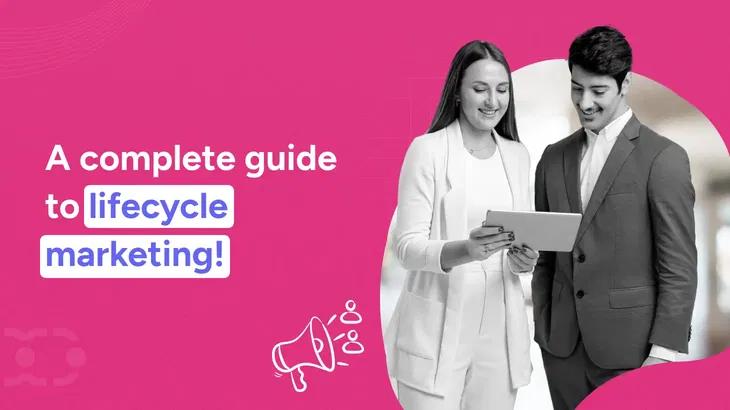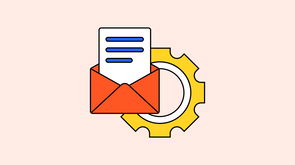-> Centralization and organization
Analyzing customer data is the lifeblood of lifecycle email marketing. With customer relationship management systems as the foundation, businesses can centralize vital customer information, such as contact details, purchase history, and engagement metrics.
This organized data repository empowers marketers to manage vast amounts of information efficiently, ensuring that nothing slips through the cracks and that insights are gained from each customer interaction.
-> Personalization and segmentation
Data is the key to truly personalized marketing. 71% of customers expect companies to deliver personalized experiences, and 76% can get frustrated when it does not happen.
By segmenting customers based on behaviors, preferences, and lifecycle stages, you can deliver highly relevant content and offers that resonate with each customer.
This precision in targeting leads to stronger engagement, improved conversion rates, and a customer experience that feels tailor-made for each individual.
-> Automation at scale
One of data's most powerful benefits is its ability to fuel automation. Accurate and up-to-date data ensures that workflows are triggered correctly and in the right context.
Whether it's nurturing leads or sending timely follow-up emails, automation platforms rely on data to ensure efficient and effective customer lifecycle marketing campaigns.
Data-driven automated campaigns consistently outperform traditional ones in open and click-through rates, saving time while driving better results.
-> Analytics and optimization
For the marketing team, data is not just about records but also helps in measuring success and refining strategies. Through robust predictive analytics tools, marketers can track key metrics such as conversion rates, customer lifetime value (CLV), and return on investment (ROI).
These insights provide actionable intelligence, enabling data-driven decisions and continuous adjustments to marketing strategies for maximum impact.
Must read: A guide to B2B marketing strategies!
-> Continuous improvement
The beauty of data is that it creates a feedback loop that drives ongoing optimization. Marketers can identify bottlenecks, test new approaches, and adapt to changing customer needs by analyzing customer behavior and campaign performance.
This iterative process ensures that campaigns stay relevant and effective over time, helping brands stay ahead of the curve in a fast-changing market.
Lifecycle marketing campaigns: With real life examples
The lifecycle marketing examples can help you know how brands have adapted this strategy to elevate the overall customer experience for their business:
-> Awareness stage campaign for better marketing efforts
Example: Nike's "Just Do It" campaign
- Objective: Increase brand visibility and inform consumers of Nike's values and products.
- How it works: Nike runs large-scale marketing campaigns (both digital and traditional) focusing on inspiring individuals to push beyond their limits. They target new audiences through TV commercials, social media content, and influencer partnerships to increase awareness of their brand and products.
-> Engagement stage campaign to engage customers
Example: HubSpot's educational content
- Objective: Engage potential customers and encourage interaction with the brand's content.
- How it works: HubSpot engages visitors through free resources such as blogs, eBooks, webinars, and templates. They offer free marketing automation courses and webinars that allow users to engage with their platform while learning about inbound marketing.
-> Consideration stage campaign for a successful lifecycle marketing strategy
Example: Shopify's free trial offers
- Objective: Move customers from awareness to consideration by allowing them to experience the product.
- How it works: Shopify offers a 14-day free trial where customers can explore the platform's e-commerce capabilities without commitment. During this trial period, Shopify provides tutorials, resources, and live support to guide users and address questions.
-> Conversion stage campaign for target audience
Example: Spotify's subscription upgrade offer
- Objective: Convert free users to paid subscribers.
- How it works: Spotify offers limited-time promotions where free-tier users receive discounts or extended trial periods for the paid version of Spotify Premium. They highlight features like ad-free listening, offline playback, and improved sound quality to encourage users to upgrade.
-> Retention stage campaign for customer lifetime
Example: Amazon's personalized recommendations
- Objective: Keep customers engaged and encourage repeat purchases.
- How it works: Amazon sends personalized emails or recommendations based on past purchases, browsing history, and other preferences. The platform uses data to suggest products customers likely need or want, improving retention and encouraging future purchases.
-> Loyalty stage campaign for customer lifecycle marketing strategy
Example: Starbucks' rewards program
- Objective: Foster customer loyalty and repeat business.
- How it works: Starbucks has a tiered loyalty program where customers earn stars for every purchase, which can be redeemed for free products or exclusive offers. Regular customers are rewarded with personalized offers, birthday rewards, and special promotions based on their buying habits.
Salesmate: The best tool for lifecycle marketing for your business!
Salesmate excels as a lifecycle marketing software by offering end-to-end automation, customer journey analytics, and personalized engagement across all stages of the customer lifecycle. Here's how it addresses each critical phase:
Wrap up!
Lifecycle marketing is a powerful strategy that nurtures customers from their first interaction with your brand to becoming loyal advocates.
By understanding the different stages of awareness, engagement, consideration, conversion, retention, loyalty, and advocacy, you can tailor your approach to meet your customers' needs and build deeper, more meaningful relationships.
With personalized content, multi-channel engagement, and a focus on retention, lifecycle marketing helps transform one-time buyers into repeat customers, ultimately driving long-term growth for your business.
The key is to provide value at every stage of lifecycle marketing efforts and continuously optimize your efforts based on customer behavior and feedback.
By adopting lifecycle marketing strategies, you're not just acquiring customers. You're creating loyal fans who advocate for your brand and help you grow organically.





![Follow up email template 15 Best follow up email templates [With best examples]](/mm-images/follow-up-email-template-iquligf6.webp?width=295)

Key takeaways
In today's world, where customers get any product in under 10 minutes, their expectations remain at an all-time high, and providing a personalized and timely experience is more important than ever.
Lifecycle marketing empowers brands to engage with customers at each stage of their journey, whether they are just discovering your brand, making a purchase, or returning for another transaction.
By aligning your marketing strategies with the customers' needs and preferences, you can drive better engagement, improve conversion rates, and build long-term loyalty.
This approach strengthens your connection with your audience, increases customer lifetime value, and gives you a competitive edge. This guide will help you harness lifecycle marketing to enhance your business outcomes.
What is lifecycle marketing?
Lifecycle marketing is a customer-centric strategy designed to guide and engage customers throughout their journey with your brand.
From the moment they first discover your company to the point where they become loyal advocates and repeat buyers, lifecycle marketing focuses on nurturing lasting customer relationships.
Unlike traditional marketing approaches, which prioritize immediate sales or customer acquisition costs, a comprehensive lifecycle marketing strategy strives to maximize customer lifetime value by delivering personalized, relevant interactions at every customer journey stage.
What are the key stages of lifecycle marketing?
The marketing lifecycle stages demand unique, tailored strategies that enhance engagement, drive conversion, and build long-term value. Below is an overview of the key stages of lifecycle marketing:
1) Awareness
Awareness can help in introducing your brand to a new audience and generate interest in your business.
At the awareness stage, potential customers first encounter your brand, products, or services. The goal is to make a strong first impression and spark curiosity about your offer.
Strategies to use:
Key goal: Get on the radar of your target audience and ignite their interest in your offerings.
Generate more leads through Salesmate!
Capture, nurture and convert leads seamlessly with this next gen powerful tool
2) Engagement
Nurture potential customers by providing relevant, personalized content that keeps them interested.
Right now, the average open rate of an email marketing campaign is 35.6%. Once your sales prospects know your brand, the next step is to engage them with personalized and relevant interactions that guide them deeper into the customer journey.
This lifecycle marketing stage focuses on creating a meaningful connection.
Strategies to use:
Key goal: Deepen the relationship, providing value and creating a connection with prospects.
3) Consideration
At this stage, prospects actively evaluate different options, comparing your brand to competitors. It's crucial to provide detailed and convincing content demonstrating why your solution is the best choice.
Strategies to use:
Key goal: Address any objections, answer questions, and reinforce your brand as the best solution for their needs.
4) Conversion
Encourage prospects to take action and become customers.
Conversion is when prospects decide to purchase or take a desired action, such as signing up for a service or subscribing to a newsletter. Clear and compelling strategies are essential to close the deal.
Strategies to use:
Key goal: Remove barriers to conversion and make it as easy as possible for prospects to become paying customers.
5) Retention
Foster customer loyalty by providing ongoing value and engagement.
After the initial purchase, the focus shifts to retaining customers and keeping them satisfied so they continue to buy from you. This stage is critical for maximizing customer lifetime value and reducing churn.
Strategies to use:
Key goal: Keep customers happy and engaged, ensuring they return and continue to buy from you.
6) Loyalty
Build long-term brand loyalty and encourage repeat purchases.
Loyal customers are those who consistently choose your brand over competitors. At this stage, the focus is on deepening loyalty and turning customers into brand advocates.
Strategies to use:
Key goal: Foster long-term loyalty and advocacy, transforming customers into brand ambassadors who will promote your business to others.
How important is data in lifecycle marketing?
Data is at the core of a lifecycle marketing plan. It fuels every stage of the customer's journey, enabling the personalization, automation, and continuous optimization that make successful lifecycle marketing.
Data plays a crucial role in optimizing each phase of the customer journey:
-> Centralization and organization
Analyzing customer data is the lifeblood of lifecycle email marketing. With customer relationship management systems as the foundation, businesses can centralize vital customer information, such as contact details, purchase history, and engagement metrics.
This organized data repository empowers marketers to manage vast amounts of information efficiently, ensuring that nothing slips through the cracks and that insights are gained from each customer interaction.
-> Personalization and segmentation
Data is the key to truly personalized marketing. 71% of customers expect companies to deliver personalized experiences, and 76% can get frustrated when it does not happen.
By segmenting customers based on behaviors, preferences, and lifecycle stages, you can deliver highly relevant content and offers that resonate with each customer.
This precision in targeting leads to stronger engagement, improved conversion rates, and a customer experience that feels tailor-made for each individual.
-> Automation at scale
One of data's most powerful benefits is its ability to fuel automation. Accurate and up-to-date data ensures that workflows are triggered correctly and in the right context.
Whether it's nurturing leads or sending timely follow-up emails, automation platforms rely on data to ensure efficient and effective customer lifecycle marketing campaigns.
Data-driven automated campaigns consistently outperform traditional ones in open and click-through rates, saving time while driving better results.
-> Analytics and optimization
For the marketing team, data is not just about records but also helps in measuring success and refining strategies. Through robust predictive analytics tools, marketers can track key metrics such as conversion rates, customer lifetime value (CLV), and return on investment (ROI).
These insights provide actionable intelligence, enabling data-driven decisions and continuous adjustments to marketing strategies for maximum impact.
-> Continuous improvement
The beauty of data is that it creates a feedback loop that drives ongoing optimization. Marketers can identify bottlenecks, test new approaches, and adapt to changing customer needs by analyzing customer behavior and campaign performance.
This iterative process ensures that campaigns stay relevant and effective over time, helping brands stay ahead of the curve in a fast-changing market.
Lifecycle marketing campaigns: With real life examples
The lifecycle marketing examples can help you know how brands have adapted this strategy to elevate the overall customer experience for their business:
-> Awareness stage campaign for better marketing efforts
Example: Nike's "Just Do It" campaign
-> Engagement stage campaign to engage customers
Example: HubSpot's educational content
-> Consideration stage campaign for a successful lifecycle marketing strategy
Example: Shopify's free trial offers
-> Conversion stage campaign for target audience
Example: Spotify's subscription upgrade offer
-> Retention stage campaign for customer lifetime
Example: Amazon's personalized recommendations
-> Loyalty stage campaign for customer lifecycle marketing strategy
Example: Starbucks' rewards program
Salesmate: The best tool for lifecycle marketing for your business!
Salesmate excels as a lifecycle marketing software by offering end-to-end automation, customer journey analytics, and personalized engagement across all stages of the customer lifecycle. Here's how it addresses each critical phase:
Supercharge your lifecycle marketing with Salesmate!
Effortlessly manage and engage your customers at every stage of their journey
Wrap up!
Lifecycle marketing is a powerful strategy that nurtures customers from their first interaction with your brand to becoming loyal advocates.
By understanding the different stages of awareness, engagement, consideration, conversion, retention, loyalty, and advocacy, you can tailor your approach to meet your customers' needs and build deeper, more meaningful relationships.
With personalized content, multi-channel engagement, and a focus on retention, lifecycle marketing helps transform one-time buyers into repeat customers, ultimately driving long-term growth for your business.
The key is to provide value at every stage of lifecycle marketing efforts and continuously optimize your efforts based on customer behavior and feedback.
By adopting lifecycle marketing strategies, you're not just acquiring customers. You're creating loyal fans who advocate for your brand and help you grow organically.
Frequently asked questions
1. How does lifecycle marketing differ from traditional marketing?
Lifecycle marketing differs from traditional marketing in several ways:
Relationship focus: Lifecycle marketing emphasizes building long-term relationships and engaging customers at every stage of their journey, from awareness to advocacy. Traditional marketing typically focuses on short-term goals and one-time transactions.
Personalization: It uses customer data to deliver personalized, relevant messages based on where each customer is in their journey. Traditional marketing often relies on broad, one-size-fits-all campaigns.
Long-term engagement: It nurtures customers continuously, even after a purchase, to drive loyalty and repeat business. Traditional marketing usually centers on acquiring new customers and ends after the sale.
Omnichannel approach: Lifecycle marketing engages across multiple channels through customer relationship management, while traditional marketing messages may use single or limited channels.
Data and automation: Leverages real-time data and marketing automation tools for timely, targeted communication. Traditional marketing is less data-driven and rarely automated.
2. What are the main goals of lifecycle marketing?
The main goals of the lifecycle marketing process are:
3. What role does customer segmentation play in lifecycle marketing?
Customer segmentation is central to effective lifecycle marketing, as it enables brands to deliver personalized, relevant communications and experiences based on where each customer is in their journey with the brand.
4. Why is lifecycle marketing important for businesses?
The lifecycle marketing model is important for businesses because it enables them to build long-term, profitable relationships with customers by engaging them at every stage of their journey, from initial awareness to loyal advocacy.
Unlike traditional marketing, which often focuses solely on acquisition or one-time sales, lifecycle marketing emphasizes acquiring new and retaining existing customers, ensuring consistent recurring revenue and higher customer lifetime value.
5. What are the common challenges in lifecycle marketing?
Businesses implementing customer lifecycle stages often face several recurring challenges that can hinder campaign effectiveness and ROI:
Juhi Desai
Content WriterJuhi is a passionate writer and reader. She is working with the team of content creators at Salesmate. Always seeking to learn something new, Juhi has an optimistic approach towards life. When she is not writing you can find her with a book and a coffee by her side.